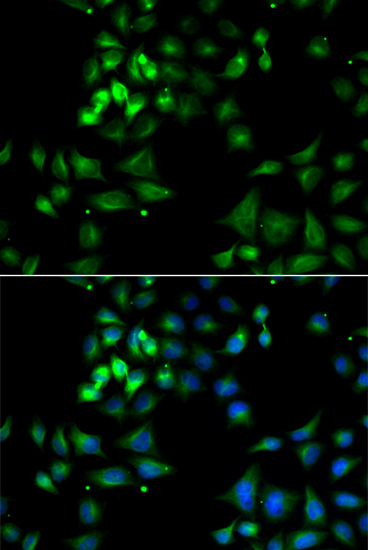Metabolism Antibodies 1
Anti-HYOU1 Antibody (CAB12313)
- SKU:
- CAB12313
- Product Type:
- Antibody
- Reactivity:
- Human
- Host Species:
- Rabbit
- Isotype:
- IgG
- Antibody Type:
- Polyclonal Antibody
- Research Area:
- Metabolism
Description
| Antibody Name: | Anti-HYOU1 Antibody |
| Antibody SKU: | CAB12313 |
| Antibody Size: | 20uL, 50uL, 100uL |
| Application: | IF |
| Reactivity: | Human |
| Host Species: | Rabbit |
| Immunogen: | Recombinant fusion protein containing a sequence corresponding to amino acids 1-140 of human HYOU1 (NP_001124463.1). |
| Application: | IF |
| Recommended Dilution: | IF 1:50 - 1:200 |
| Reactivity: | Human |
| Positive Samples: |
| Immunogen: | Recombinant fusion protein containing a sequence corresponding to amino acids 1-140 of human HYOU1 (NP_001124463.1). |
| Purification Method: | Affinity purification |
| Storage Buffer: | Store at -20'C. Avoid freeze / thaw cycles. Buffer: PBS with 0.02% sodium azide, 50% glycerol, pH7.3. |
| Isotype: | IgG |
| Sequence: | MADK VRRQ RPRR RVCW ALVA VLLA DLLA LSDT LAVM SVDL GSES MKVA IVKP GVPM EIVL NKES RRKT PVIV TLKE NERF FGDS AASM AIKN PKAT LRYF QHLL GKQA DNPH VALY QARF PEHE LTFD PQRQ TVHF QISS |
| Gene ID: | 10525 |
| Uniprot: | Q9Y4L1 |
| Cellular Location: | Endoplasmic reticulum lumen |
| Calculated MW: | 62kDa/111kDa |
| Observed MW: |
| Synonyms: | HYOU1, GRP-170, Grp170, HSP12A, ORP-150, ORP150 |
| Background: | The protein encoded by this gene belongs to the heat shock protein 70 family. This gene uses alternative transcription start sites. A cis-acting segment found in the 5' UTR is involved in stress-dependent induction, resulting in the accumulation of this protein in the endoplasmic reticulum (ER) under hypoxic conditions. The protein encoded by this gene is thought to play an important role in protein folding and secretion in the ER. Since suppression of the protein is associated with accelerated apoptosis, it is also suggested to have an important cytoprotective role in hypoxia-induced cellular perturbation. This protein has been shown to be up-regulated in tumors, especially in breast tumors, and thus it is associated with tumor invasiveness. This gene also has an alternative translation initiation site, resulting in a protein that lacks the N-terminal signal peptide. This signal peptide-lacking protein, which is only 3 amino acids shorter than the mature protein in the ER, is thought to have a housekeeping function in the cytosol. In rat, this protein localizes to both the ER by a carboxy-terminal peptide sequence and to mitochondria by an amino-terminal targeting signal. Alternative splicing results in multiple transcript variants. |
| UniProt Protein Function: | HYOU1: Has a pivotal role in cytoprotective cellular mechanisms triggered by oxygen deprivation. May play a role as a molecular chaperone and participate in protein folding. Belongs to the heat shock protein 70 family. |
| UniProt Protein Details: | Protein type:Heat shock protein; Chaperone Chromosomal Location of Human Ortholog: 11q23.1-q23.3 Cellular Component: endoplasmic reticulum lumen; extracellular region; focal adhesion; membrane; smooth endoplasmic reticulum Molecular Function:chaperone binding Biological Process: ER to Golgi vesicle-mediated transport; receptor-mediated endocytosis |
| NCBI Summary: | The protein encoded by this gene belongs to the heat shock protein 70 family. This gene uses alternative transcription start sites. A cis-acting segment found in the 5' UTR is involved in stress-dependent induction, resulting in the accumulation of this protein in the endoplasmic reticulum (ER) under hypoxic conditions. The protein encoded by this gene is thought to play an important role in protein folding and secretion in the ER. Since suppression of the protein is associated with accelerated apoptosis, it is also suggested to have an important cytoprotective role in hypoxia-induced cellular perturbation. This protein has been shown to be up-regulated in tumors, especially in breast tumors, and thus it is associated with tumor invasiveness. This gene also has an alternative translation initiation site, resulting in a protein that lacks the N-terminal signal peptide. This signal peptide-lacking protein, which is only 3 amino acids shorter than the mature protein in the ER, is thought to have a housekeeping function in the cytosol. In rat, this protein localizes to both the ER by a carboxy-terminal peptide sequence and to mitochondria by an amino-terminal targeting signal. Alternative splicing results in multiple transcript variants. [provided by RefSeq, Mar 2014] |
| UniProt Code: | Q9Y4L1 |
| NCBI GenInfo Identifier: | 10720185 |
| NCBI Gene ID: | 10525 |
| NCBI Accession: | Q9Y4L1.1 |
| UniProt Secondary Accession: | Q9Y4L1,Q2I204, Q53H25, A8C1Z0, B7Z909, |
| UniProt Related Accession: | Q9Y4L1 |
| Molecular Weight: | 62,757 Da |
| NCBI Full Name: | Hypoxia up-regulated protein 1 |
| NCBI Synonym Full Names: | hypoxia up-regulated 1 |
| NCBI Official Symbol: | HYOU1 |
| NCBI Official Synonym Symbols: | Grp170; HSP12A; ORP150; GRP-170; ORP-150 |
| NCBI Protein Information: | hypoxia up-regulated protein 1 |
| UniProt Protein Name: | Hypoxia up-regulated protein 1 |
| UniProt Synonym Protein Names: | 150 kDa oxygen-regulated protein; ORP-150; 170 kDa glucose-regulated protein; GRP-170 |
| Protein Family: | Hypoxia up-regulated protein |
| UniProt Gene Name: | HYOU1 |
| UniProt Entry Name: | HYOU1_HUMAN |
 | Immunofluorescence analysis of A549 cells using HYOU1 antibody (CAB12313). Blue: DAPI for nuclear staining. |
View AllClose






